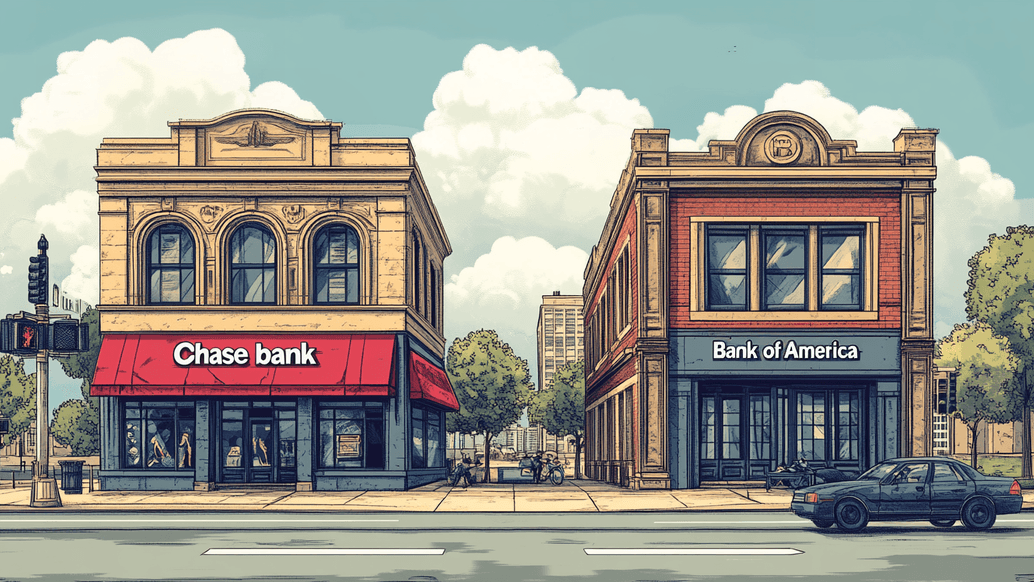Chase vs. Bank of America: Which Is Better for You?

When talking about the top banks in the United States, there are two that immediately come to mind: Bank of America and Chase. Both have impressive total assets and offer a wide selection of financial services—credit cards, checking accounts, savings accounts, and more.
So, is Chase or Bank of America better? While the two banks are pretty similar in terms of what they offer, there are still notable differences that can make one more suitable than the other. Keep reading our review to compare Chase vs. Bank of America pros and cons and make an informed decision on the matter.
Bank of America vs. Chase Checking Accounts: Comparing Key Features
A checking account is a common financial service that most banks offer, so our Chase vs. Bank of America review will start with it. Both banks provide a range of checking accounts, from standard to premium. Let’s discuss the low-fee options—Bank of America Advantage Plus Banking and Chase Total Checking accounts.
| Bank of America Advantage Plus Banking | Chase Total Checking |
|---|---|---|
Minimum initial deposit | $100 | $0 |
Minimum balance | $1,500 balance (or $250 in direct deposits monthly) | $1,500 balance (or $500 in direct deposits monthly) |
Monthly fee | $12 | $12 |
Welcome bonus | $200 bonus | $300 bonus |
APY | Absent | Absent |
Overdraft fee | $10 | $34 |
As you can see, there are lots of similarities, but the differences are also there. The drawback of Advantage Plus Banking is that you are required to deposit at least $100, while Total Checking doesn’t have this condition. Depending on your financial situation, this can be a crucial factor in deciding which service is right for you.
Note that both banks offer a way to waive the monthly service fee when you use their checking accounts. In the case of Chase, you can avoid paying the fee by depositing at least $500 every month. As for Bank of America, the minimum direct deposit for waiving the fee is lower—$250.
Chase Bank vs. Bank of America Savings Accounts: Comparing Key Features
If you’re considering saving some money in a specialized account, you may wonder which bank is better: Chase or Bank of America. Here’s a comparison of the top savings account options from the two banks.
| Bank of America Advantage Savings | Chase Savings |
|---|---|---|
Minimum initial deposit | $100 | $0 |
Monthly fee | $8 | $5 |
APY | 0.01– 0.04% | 0.01% |
Minimum balance to waive a service fee | $500 | $300 |
It’s obvious that savings accounts won’t give you high yields, so you may want to consider other options if that’s what you’re after.
Note that the Bank of America Advantage Savings account allows you to earn APY of up to 0.04% if you become a member of the Preferred Rewards program. The program requires you to have a combined Bank of America deposit of at least $20,000 across all of your accounts.
Popular Credit Cards: Main Features Compared
Now that we have discussed checking and savings accounts, let’s focus on the next financial tool in the list—credit cards. Chase and Bank of America provide a wide selection of credit cards with various rewards, interest rates, etc. Both banks allow users to apply for their cards online.
When choosing a credit card, the most important things to consider are how you plan to use it (for traveling, grocery shopping, etc.) and whether you are willing to pay an annual fee. Also, it’s important to assess the APR of cards and whether you can meet the requirements to get a welcome bonus.
Want to know whether it's a Bank of America or Chase credit card that’s best for you? Here’s a comparison of the most popular offers from these banks.
Travel-oriented Credit Cards | ||
|---|---|---|
| Bank of America Travel Rewards | Chase Sapphire Preferred Card |
Types of rewards offered | Redeemable points | Redeemable points |
Annual fee | $0 | $95 |
Rewards rate | 1.5 travel points per dollar spent on purchases in select categories. | • 5 points per dollar spent on Chase Travel purchases; • 3 points per dollar spent on dining; • 2 points per dollar on other travel-related purchases; • 1 point per dollar on all other purchases. |
APR | 19.24–29.24% variable | 21.49–28.49% variable |
Welcome offer | 25,000 points (if you spend at least $1,000 within 90 days of opening the account) | 60,000 points (If you spend at least $4,000 within the 3 months of opening the account) |
If you are more interested in cashback than redeemable travel points, here’s a comparison of what the banks can offer.
Cash Back Credit Cards | ||
|---|---|---|
| Bank of America Customized Cash Rewards | Chase Freedom Unlimited |
Types of rewards offered | Cashback | Cashback |
Annual fee | $0 | $0 |
Rewards rate | • 3% cashback on select categories; • 2% at wholesale clubs and grocery stores; • 1% on other purchases. | • 5% on Chase travel purchases; • 3% on purchases at pharmacies and dining; • 1.5% on other purchases. |
APR | • 19.24–29.24% variable; • 0% intro APR for 15 billing cycles. | • 20.49–29.24% variable ; • 0% intro APR for 15 months. |
Welcome offer | $200 cashback (If you spend at least $1,000 within 90 days of opening the account) | $150 bonus (If you spend at least $500 on purchases within the 3 months of opening the account) |
Chase Bank: Main Pros and Cons

To help you decide whether Chase or Bank of America is the better option for your case, let’s take a look at the pros and cons of Chase compared to its competitor.
Pros
- Higher number of branch locations (more than 4,900);
- The monthly savings account fee is lower;
- Higher welcome bonus when opening a checking account (temporary offer);
- Absence of minimum initial deposit to open a checking account.
Cons
- Minimum $500 in direct deposits monthly to waive a checking account fee;
- Savings accounts have lower interest rates.
Bank of America: Main Pros and Cons

Is Chase better than Bank of America? Here are the pros and cons of the latter.
Pros
- Around 15,000 ATMs in the United States;
- Better interest rates on savings accounts (if you are a member of Preferred Rewards);
- Lower monthly direct deposit to waive a checking account fee.
Cons
- The minimum initial deposit to open a checking account is $100;
- The monthly service fee of savings accounts is higher;
- Lower welcome bonus when opening a checking account (temporary offer).




